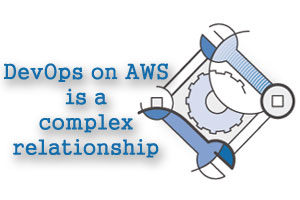Upgrade & Secure Your Future with DevOps, SRE, DevSecOps, MLOps!
We spend hours on Instagram and YouTube and waste money on coffee and fast food, but won’t spend 30 minutes a day learning skills to boost our careers.
Master in DevOps, SRE, DevSecOps & MLOps!
Learn from Guru Rajesh Kumar and double your salary in just one year.
Source:- techtarget.com
It’s important to have a fully stocked toolbox before deploying DevOps on AWS. Automation and monitoring tools, both from AWS and third parties, need to be in tune for deployment and operations to run smoothly and efficiently.
AWS provides tools that help IT teams submit, manage and deploy code — pushing applications and features into production faster. But the DevOps transition is not always easy, and errors cost time and money. Successfully deploying DevOps on AWS requires IT teams to identify common problems and use the proper tools.
We offer expert advice to some frequently asked questions about adopting DevOps on AWS.
How does AWS approach application delivery?
The move from a traditional application development mindset to a DevOps approach is a major IT transition. Enterprises make the shift to improve development efficiency, but the process requires thorough knowledge of both software and personnel changes. Certain AWS tools and services, such as CodePipeline and CodeCommit, help enable DevOps on AWS.
Continuous integration (CI) and continuous delivery (CD) are crucial components in the code delivery pipeline. AWS developers use these CI/CD pipelines to manage and automate app deployment. Native AWS tools, such as AWS CodePipeline, AWS CodeCommit and AWS CodeDeploy, enable developers to build these pipelines. Developers can also use infrastructure as code (IaC) to fully automate a cloud environment. AWS CloudFormation enables administrators to define JSON-based templates using IaC that create collections of AWS resources for particular users or projects.
Why is DevOps nirvana so difficult to reach?
The DevOps learning curve is steep, requiring a full-fledged enterprise commitment to the process and to the new technologies that accompany it. AWS’ scalability and reliability make it a suitable environment for DevOps, but many enterprises operate on legacy systems. And transitioning large, complex and often siloed enterprises into DevOps processes further complicates an already difficult migration. Businesses should evaluate their options before undertaking a DevOps transition. When switching to an AWS environment, developers need to have the skills to identify and work with the proper service for a particular application or workload. There is no shortage of available DevOps tools, so IT teams must carefully choose the right combination of native and third-party utilities for their environments. Weigh vendor lock-in potential with AWS when choosing tools.
How can we avoid errors when releasing code in AWS?
It was only a couple of years ago that Amazon made its AWS DevOps tools available outside the company. With AWS CodeCommit, CodePipeline, CodeDeploy and CodeBuild now generally available, developers can deploy code and run servers on-premises or in the cloud.
Transitioning to DevOps on AWS can help IT eliminate manual code release errors and missed updates. Automation reduces downtime; consistent code deployments mean that IT teams need to spend less time troubleshooting problems.
Native AWS DevOps tools work in conjunction with third-party development and configuration management services. For example, Bitbucket Connect works with AWS CodeDeploy. And vendors, such as CloudBees, Codeship and CircleCI, can expand DevOps capabilities in AWS.
How can Docker containers improve a DevOps pipeline?
Some developers use Docker containers to help build a CD pipeline; the containers serve as an alternative to individual Elastic Compute Cloud (EC2) instances. IT teams sometimes prefer containers over EC2 instances because of their portability and lightweight features. It takes more time to launch EC2 instances because they need their own OS. Containers, on the other hand, enable workloads to move seamlessly between cloud environments.
Docker works within a CD pipeline in various stages of application development, including local deployment, source control, build, test and launch. Developers can deploy apps into production with Amazon EC2 Container Service or AWS Elastic Beanstalk, which supports multicontainer environments.
How can we automate security during development?
Security often is an afterthought in the development process, which doesn’t sit well with security teams. Rolling security processes into the DevOps discussion can help allay concerns. A DevSecOps approach incorporates code testing, automates builds, releases software and adds security automation to the DevOps process. IT delivers necessary software updates while detecting and fixing potential security issues.
AWS tools like Identity and Access Management, AWS Config, Amazon Inspector and AWS CloudTrail natively secure DevOps pipelines. But IT teams can also turn to open source or third-party tools to add elements like password protection. Use the integration stage to identify potential weaknesses or areas of penetration against outside applications.

 Starting: 1st of Every Month
Starting: 1st of Every Month  +91 8409492687 |
+91 8409492687 |  Contact@DevOpsSchool.com
Contact@DevOpsSchool.com